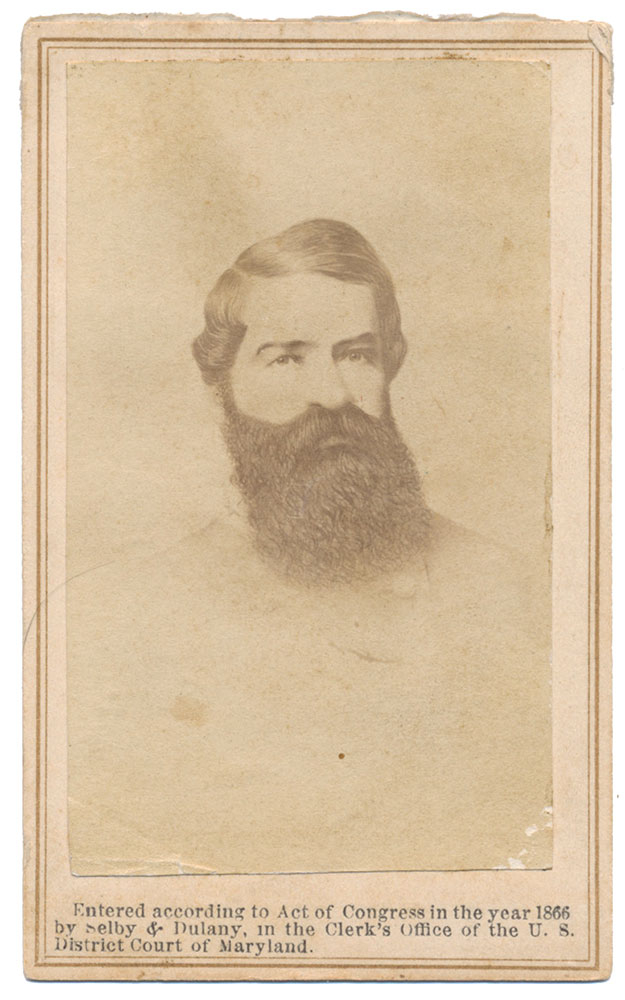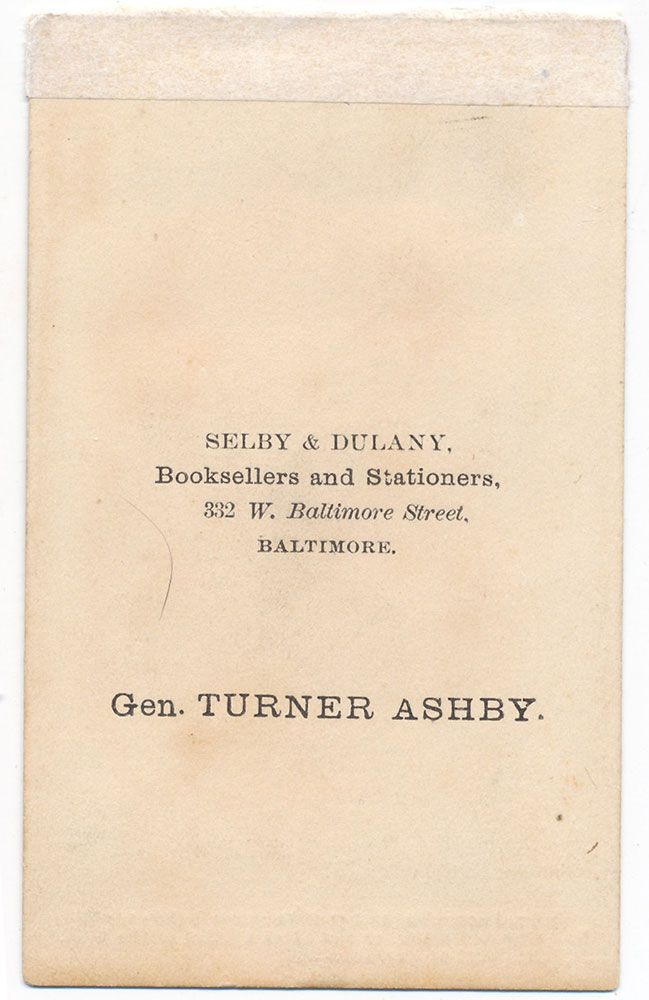site search
online catalog
1866 PUBLISHED VIEW OF CONFEDERATE HERO GENERAL TURNER ASHBY

Hover to zoom


$1,350.00
Quantity Available: 1
Item Code: 846-416
CDV is a litho/engraving bust-view of General Turner Ashby in Confederate uniform.
Contrast and clarity are good. Paper and mount are the same. Bottom center of the mount bears 1866 publishing information.
Reverse has an imprint for SELBY & DULANY… BALTIMORE with a printed caption of “GEN. TURNER ASHBY.”
Confederate Military History, vol. IV, p. 577 gives an account of Ashby’s service and life. It reads in part:
“Brigadier-General Turner Ashby… was born at Rose Hill, Fauquier County, in 1824. He was a grandson of Capt. John Ashby, of the revolutionary war.
At the time of John Brown's raid, he was captain of a volunteer cavalry company, which he led to the scene of trouble. On the 16th of April, 1861, he was at Richmond, with other bold spirits, and took part in the planning of the capture of Harper's Ferry.
The next morning, the day of the passage of the ordinance of secession, he went to his home to call out his cavalry company. His brief career from that time was of the most romantic nature, and he speedily became the idol of the volunteer troopers who rallied at Harper's Ferry in April and May, to recruit Jackson's forces.
He was assigned to command of the Confederate post at Point of Rocks, where his activity and alertness were of great value.
In June he was in command of a troop of Col. Eppa Hunton's regiment, but obtained permission to rejoin his own regiment, Col. Angus McDonald's legion, and McDonald recommended him to promotion as lieutenant-colonel, speaking of him at this early date, June 25th, as "already known as one of the best partisan leaders in the service. "
Meanwhile Ashby, in addition to his other duties, had attracted attention by his daring in making a trip to Chambersburg, Pa., disguised and unattended, and obtaining complete information regarding the Federal force under Patterson. He was soon promoted lieutenant-colonel, and the rank of colonel followed in a few months.
While Johnston was moving to Manassas, to the support of Beauregard, Ashby and Stuart, with their cavalry commands, were very successful in masking the transfer of the troops until it was too late for Patterson to have any influence upon the battle of July 21st.
In October, General Jackson was assigned to the Valley district, and Ashby, as colonel of the Seventh Virginia Cavalry, was put in command of the cavalry. In February he was authorized by the war department to raise cavalry, infantry and heavy artillery…
In March he withdrew with Jackson from Winchester, before the advance on Banks, but on the 22nd returned and by an audacious attack drove in the enemy's outposts.
The battle of Kernstown immediately followed, in which Ashby, with his cavalry and artillery, and an infantry support, rendered effective service upon the Confederate right. After this Jackson was rapidly reinforced, and Ashby's force was recruited to the dignity of a brigade, though his commission as brigadier-general was not issued until May 23rd.
He pursued the Federals after the battle of McDowell, played a prominent part in the rout of the Federals at Middletown, and defended the rear during the Confederate retreat up the Valley early in June. On the 3rd his horse was shot under him while his men were burning the bridge over the Shenandoah.
"Ashby has infernal activity and ingenuity in this way," Shields reported to Washington. On June 6th, near Harrisonburg, he repulsed an attack, capturing the Federal commander, Sir Percy Wyndham.
He immediately planned an ambush of the pursuing Federal advance, and a fierce combat ensued. As Ashby led the attack, his horse was shot under him, and he rushed forward on foot, urging his men to charge, when a ball pierced his breast and he fell forward dead.
His death was felt as a severe loss to the army. Jackson wrote to General Imboden: "Poor Ashby is dead. He fell gloriously. I know you will join with me in mourning the loss of our friend, one of the noblest men and soldiers in the Confederate army."
In his official report he wrote: "As a partisan officer, I never knew his superior. His daring was proverbial, his powers of endurance almost incredible, his tone of character heroic, and his sagacity almost intuitive in divining the purposes and movements of the enemy."
In October, 1866, his body was reinterred with impressive ceremonies in the Stonewall cemetery at Winchester, where the anniversary of his death is annually commemorated by the strewing of flowers upon the graves of the unknown dead.” [ad] [ph:L]
~~~~~~~~~~~~~~~~~~~~~~~~~~~~~~~~~~~
THIS ITEM, AS WITH ALL OTHER ITEMS AVAILABLE ON OUR WEB SITE,
MAY BE PURCHASED THROUGH OUR LAYAWAY PROGRAM.
CLICK HERE FOR OUR POLICIES AND TERMS.
THANK YOU!
Inquire About 1866 PUBLISHED VIEW OF CONFEDERATE HERO GENERAL TURNER ASHBY
Most Popular
Historical Firearms Stolen From The National Civil War Museum In Harrisburg, Pa »
Theft From Gravesite Of Gen. John Reynolds »
Selection Of Unframed Prints By Don Troiani »
Fine Condition Brass Infantry Bugle Insignia »
Large English Bowie Knife With Sheath 1870’S – 1880’S »
Imported (Clauberg) Us Model 1860 Light Cavalry Officer's Saber »
featured item
"HOMESPUN" CONFEDERATE SHELL JACKET - PVT WILLIAM B. MARSHALL, 2ND LOUISIANA CAVALRY
Private/trooper William B. Marshall trooper 2nd Louisiana cavalry wore this jacket until his death in a Union prison. Prior to it being in the Texas Civil War Museum it was the property of the author and highly respected collector Mr. Steven… (1268-367). Learn More »


